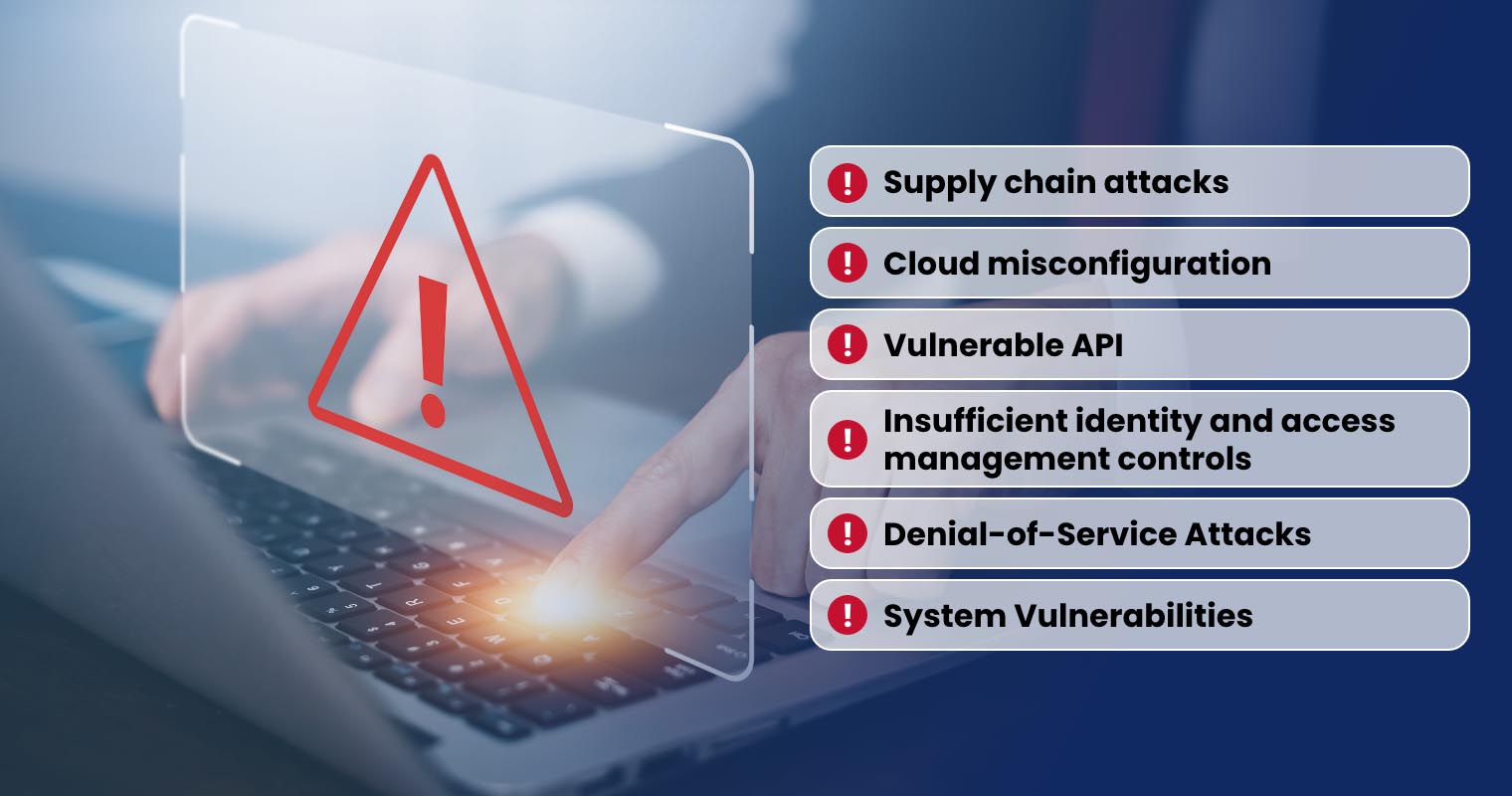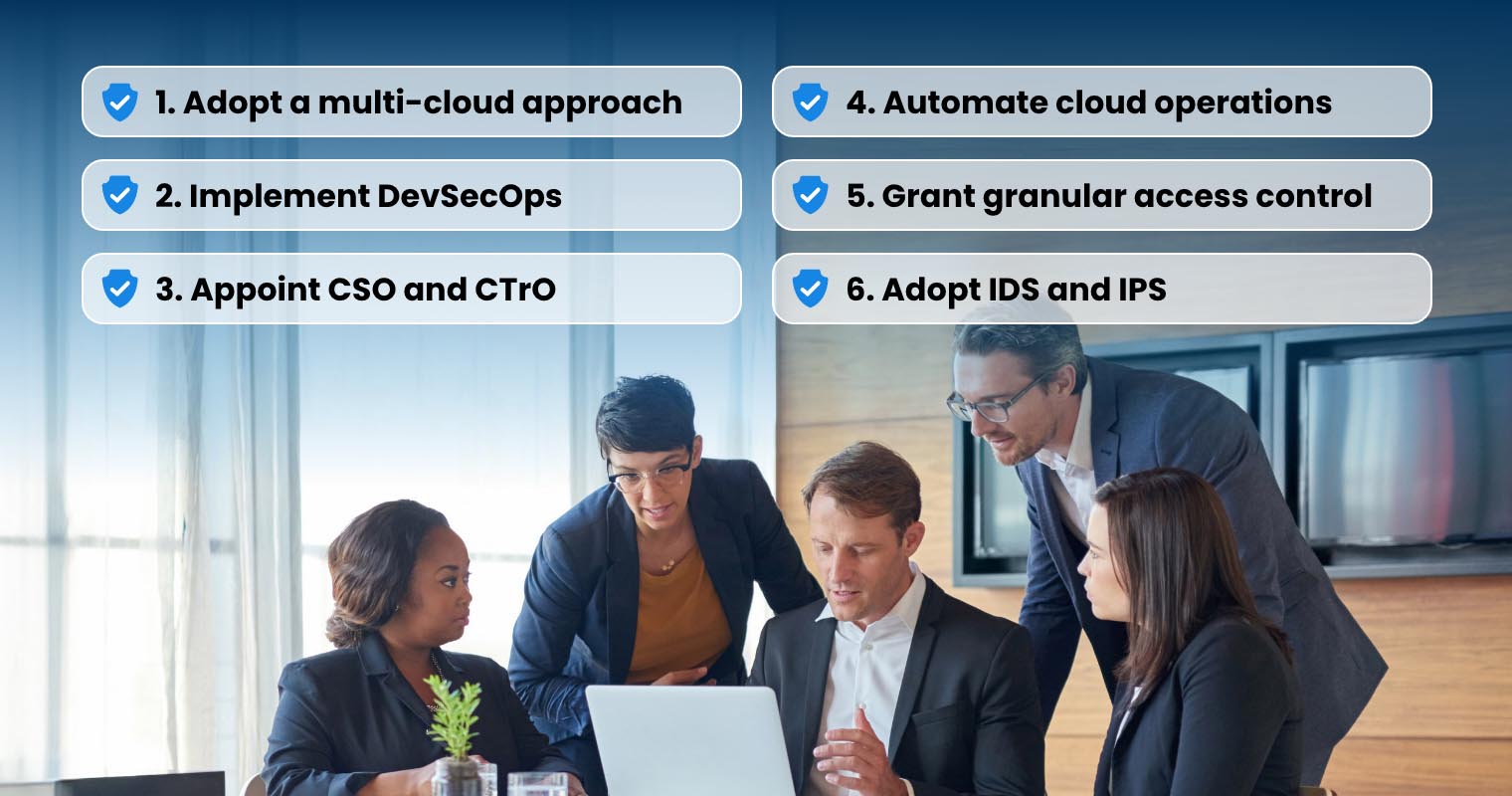Cloud hosting is becoming the norm due to its efficiency, accessibility, flexibility, and scalability. Not only that, but it also optimizes IT expenses and encourages collaboration. However, with the rise of digitalization comes a surge of cloud security risks. With such threats, business leaders must be attentive to the cloud security of their businesses.
What is cloud security?
Cloud security, also known as cloud computing security, is a set of preventive measures created to keep one’s infrastructure, data, and applications safe. Generally, this collection of procedures provides data privacy protection, resource access control, and user or device authentication.
In other words, cloud security is made to address both internal and external threats — particularly for businesses moving toward digital transformation.
Why is cloud security important?
Today, more and more businesses are quickly transitioning to cloud-based environments, and SaaS, PaaS, and IaaS computing models. This, however, demands organizations to understand security requirements to keep their data safe and avoid serious implications.
Not taking proactive steps to improve cloud security can lead to significant compliance and IT governance risks. From data to workloads, companies are responsible for keeping everything on the cloud safe from attacks.
Top Cloud Security Threats to Watch For

As more applications and data are being moved to the cloud, security for such environments grows to be a significant concern. According to the 2023 Thales Cloud Security Study, 39% of businesses experienced a data breach in their cloud environment in 2022, an increase from 35% in 2021.
Continue reading to find out the top cloud security threats your company should watch out for.
Supply chain attacks
In these attacks, cyberattackers prey on software supply chains that offer third-party cloud-based solutions. The third party acts as a backdoor for attackers to expose the organization’s cloud data controlled by the third parties.
Consequently, identity-based supply chain risk is becoming a more prominent threat nowadays. This risk is rooted in granting third parties excessive permissions on a cloud environment.
Even though the target is just one supply chain, the magnitude of the attack increases as multiple partners are compromised. One of these defacing supply chain attacks is the SolarWinds attack. The company’s product, Orion, a network management system, has been used by thousands of clients worldwide, including US government agencies and Fortune 500 companies. In 2020, the malware was deployed through SolarWinds software update that was signed by a digital certificate bearing their name — affecting 18,000 Orion users around the globe.
Likewise, Kroger, a popular supermarket chain, has also fallen victim to a supply chain attack. Accellion, the third-party service that it uses to transfer files securely, was affected by a data security incident. Important files, such as human resources data, pharmacy and customer information, and client and money services records, were affected.
Cloud misconfiguration
The need for fast-paced cloud migration might lead to oversights and inappropriate choice of cloud configuration. Although preventable, misconfiguration is among the common threats. Even the biggest IaaS providers, such as Microsoft, are vulnerable to cloud security risks.
In 2021, Microsoft misconfigured its cloud storage, Microsoft Azure, exposing millions of sensitive internal data and records of companies, including intellectual properties (IP) and personally identifiable information (PII). The misconfiguration affected Microsoft itself, as well as diverse industries, such as healthcare, aviation, and logistics.
Moreso, cloud misconfigurations can result in regulatory compliance implications which means hefty fines as well. In 2021, for instance, Capital One was fined $80 million due to negligence in leaving sensitive financial data open to the public.
Vulnerable API
Application Programming Interfaces or APIs connect two applications, allowing them to interact, communicate, and transmit data. APIs are publicly established to give third-party partners access to software platforms. Cyberattackers identify vulnerable APIs with weak authentication as a gateway to sensitive corporate data.
For instance, hackers are on the lookout for opportunities to exploit API in scraping user data. In 2021, malicious actors gained access to publicly available user account information by exploiting LinkedIn’s API. They were able to extract and compile hundreds of millions of private information, which were then put up for sale on an underground site. Since the information is authentic, LinkedIn users became prone to phishing scams and identity theft.
Insufficient identity and access management controls
Also known as identity management, identity and access management (IAM) refers to the IT security discipline and framework for managing digital identities. In a nutshell, IAM policies ensure that only authorized users have access to systems and data.
However, transitioning data to the cloud often increases the risks of overlooking IAM policies. Oftentimes, giving unnecessary entitlement and privileges creates holes in the system. It gives malicious actors a chance to gain access as tracking these can be tedious work.
Not only that, poor password and credential practices also increase cloud insecurity. Microsoft informed the masses about the upswing in identity-based attacks and password spray attacks. Cloud accounts of high-ranking business leaders such as C-level executives are often the target of such attacks. These accounts contain corporate data that is confidential or critical to the business’ performance.
Denial-of-Service Attacks
Denial-of-Service (DoS) attacks are cyber threats that can shut down a network (or web servers) and make it inaccessible to users. Such attacks will flood the target with information or overwhelm it with service requests, triggering an infrastructure crash (due to capacity overload).
One popular type of such threat is the distributed denial-of-service (DDoS) attack. This occurs when several systems orchestrate a synchronized attack on a single target. During an attack, no users can access network resources or web services. Until today, DDoS is still deemed a highly sophisticated threat to organizations globally.
According to Netscout, there over 7.8 million DDoS attacks globally have been reported in the first half of 2023. And just recently, Amazon.com Inc’s (AMZN.O) web services division confirmed they were hit by a new type of DDoS event, along with other Internet companies including Google and Cloudflare Inc (NET.N).
System Vulnerabilities
System vulnerabilities are flaws found in an organization’s information systems, system procedures, or internal controls — which often occur through human error. Some of these cloud security risks include missing patches, zero days, weak credentials, and vulnerable misconfiguration or default settings.
In recent news, Microsoft has patched 63 vulnerabilities in its operating systems — five being qualified as zero-days with three listed as actively exploited. Attackers who exploit such vulnerabilities could obtain system privileges or bypass security checks, as Microsoft explained.
These vulnerabilities can allow cybercriminals to gain access to computer systems or groups of assets. They can exploit access points or expose sensitive data, compromising an organization’s operations and data privacy. Other types of cloud security risks are network vulnerabilities (hardware and software), process vulnerabilities, and operating system vulnerabilities.
How to Prevent Cloud Security Attacks

These emerging cloud security threats may seem overwhelming at first glance. However, don’t let these discourage you from shifting to the cloud environment, especially now that more businesses are investing in digital transformation. Cloud security challenges are omnipresent and evolve continuously, but you can still safeguard your cloud environment. Here’s how to prevent cloud attacks:
1. Adopt a multi-cloud approach
In multi-cloud, businesses can opt to employ more than one cloud service provider. This provides options and flexibility based on each provider’s unique capabilities. A multi-cloud approach can act as a safety net for organizations to minimize the impact of disruptions and downtime.
Utilizing this strategy can lead to enhanced disaster recovery, better failover options, smarter business continuity plans, and improved overall security. Moreover, taking advantage of multi-cloud providers can also result in increased productivity and efficiency. For instance, using Microsoft Azure’s deep machine learning capabilities with an OLTP system optimized for AWS transactions can help companies identify the ideal transactional system.
2. Implement DevSecOps
DevSecOps stands for development, security, and operations — an extension of the DevOps methodology. DevOps are practices that combine software development (Dev) and IT operations (Ops) to optimize a software’s development life cycle. DevSecOps, on the other hand, integrates security at each stage of that development life cycle, from initial design to final delivery.
DevSecOps aids in cloud migration and system recovery by reshaping development, architecture, and processes. Implementing DevSecOps requires organizations to conduct various tasks, including:
- security audits on existing infrastructures
- automation of security tests
- integration of security tools with DevOps tools
3. Appoint CSO and CTrO
When it comes to cybersecurity the Chief Security Officer (CSO) generally takes charge of the organization’s security strategy. They can help ensure a secure design and implementation of cloud infrastructure. This may include data protection, identity and access management, incident response planning, and so on.
Working along with the CSO is the Chief Trust Officer (CTrO). Appointing a CTrO can help ensure all customer data in the cloud are handled with integrity. These officers also have an active part in creating trust strategies emphasizing security, compliance, and transparency. A CTrO is also often positioned at the forefront of response teams leading preemptive efforts and conducting risk assessments.
4. Automate cloud operations
Manual workloads associated with overseeing cloud infrastructure often result in misconfigurations and human errors. Automating routine processes such as cloud operations can help free up valuable business resources. It helps companies allocate human expertise to more delicate aspects of cloud management.
Automation in cloud operations may cover the provisioning and scaling of resources, configuration management, reinforced security baselines, and standardized settings across the cloud.
5. Grant granular access control
Another strategic approach to consider is granular access control. This involves defining and managing cloud user roles with specific entitlements and privileges — which is also vital to governing permissions effectively.
Another aspect of granular access control is ensuring the traceability of permissions to individual users. This requires organizations to maintain audit trails and detailed logs that record who accessed what resources and when.
Cloud service providers usually offer Identity and Access Management (IAM) tools (e.g. AWS IAM and Azure Active Directory) to facilitate the creation and management of user roles.
6. Adopt IDS and IPS
It is advisable to have an Intrusion Detection System or IDS and Intrusion Prevention System or IPS as part of your cloud infrastructure. Both systems scrutinize whether certain traffic resembles a threat.
IDS can act as a vigilant watchdog for your cloud system. It utilizes sophisticated algorithms and predefined signatures to identify patterns of common malicious attack patterns and any form of suspicious activity.
Unlike an IDS that acts like an observer, an IPS takes a more proactive stance by actively intervening to thwart potential threats. IPS can automatically filter out or block suspicious data packets. It can also instantly deny access or modify firewall rules once an attack signature is identified.
By adopting both IDS and IPS, organizations can create a layered defense mechanism and enhance overall security posture.
Frequently Asked Questions About Cloud Security Threats and Solutions
How do I know if my data is secure in the cloud?
A few practices to ensure the security of your data in the cloud include: (1) regularly audit your cloud provider’s security measures, (2) implement encryption protocols both during data transit and while at rest in the cloud, and (3) closely monitor access logs and employ security tools that facilitate anomaly detection.
How can I ensure compliance with cloud security regulations?
Depending on your industry, it’s best to first familiarize yourself with relevant standards such as GDPR or HIPAA. Make sure to also choose a cloud service provider that aligns with these regulations and offers compliant services. Lastly, implement security controls within the cloud infrastructure and conduct regular audits to ensure continuous adherence to regulatory requirements.
What should I do if my organization experiences a data breach in the cloud?
In most cases, the first thing to do is immediately isolate the affected systems to avoid further compromise. Next, in compliance with data breach notification requirements, you must notify all relevant parties including customers and regulatory authorities. And most importantly, conduct a thorough investigation into the breach’s scope and origin. It is critical to carry out corrective measures to prevent similar incidents in the future.
What is the role of encryption in cloud security?
Encryption plays a pivotal role in tightening cloud security. By encrypting data during transit and at rest, you add an extra layer of cloud-based threat protection against unauthorized access. This also safeguards the sensitive information then mitigates the risk of data exposure in the event of security breaches.
How can I ensure cloud provider security in a shared responsibility model?
Understand first the division of responsibilities between you and your cloud provider. What are the security responsibilities of your provider? What are yours? At the same time, implement strong security measures for your data and applications in the cloud. Regularly reviewing and updating security configurations and access controls can also help in maintaining a secure cloud environment.
Switch to a Secure Cloud Environment with Convene

Shifting to the cloud has been the trend for businesses for data storage and streamlining workloads. However, the cloud environment is not spared from the rapid growth of cloud security issues and breaches. Cracks in the cloud system and service providers are being exploited by malicious actors to obtain sensitive cloud assets. But, these can be prevented given the right strategies and tools.
When considering adopting cloud digital solutions, robust SaaS security and secure cloud storage should be at the top of the minds of business leaders. Convene is a board management software that prides itself on providing smart, simple, and secure management of sensitive high-level data and assets of your business.
Convene has teamed up with Amazon Web Services (AWS), the leading provider of cloud services in the industry. This ensures that Convene provides enterprise-grade cloud hosting to its clients, guaranteeing cloud-based threat protection on all levels against infrastructure attacks. Convene is fully equipped with a 24/7 Intrusion Detection System (IDS) and 24/7 Intrusion Prevention System (IPS) to ensure maximum cloud security.
With Convene, an additional encrypted layer that protects all your cloud assets. Data in the cloud are segmented and stored separately from each other to ensure that data does not leak or overlap. Convene protects your business through individual authentication credentials and unique keys. It employs the latest secure user authentication methods, making use of encryption technology and biometric authentication.
Learn more about Convene and book a demo now!
Jielynne is a Content Marketing Writer at Convene. With over six years of professional writing experience, she has worked with several SEO and digital marketing agencies, both local and international. She strives in crafting clear marketing copies and creative content for various platforms of Convene, such as the website and social media. Jielynne displays a decided lack of knowledge about football and calculus, but proudly aces in literary arts and corporate governance.










